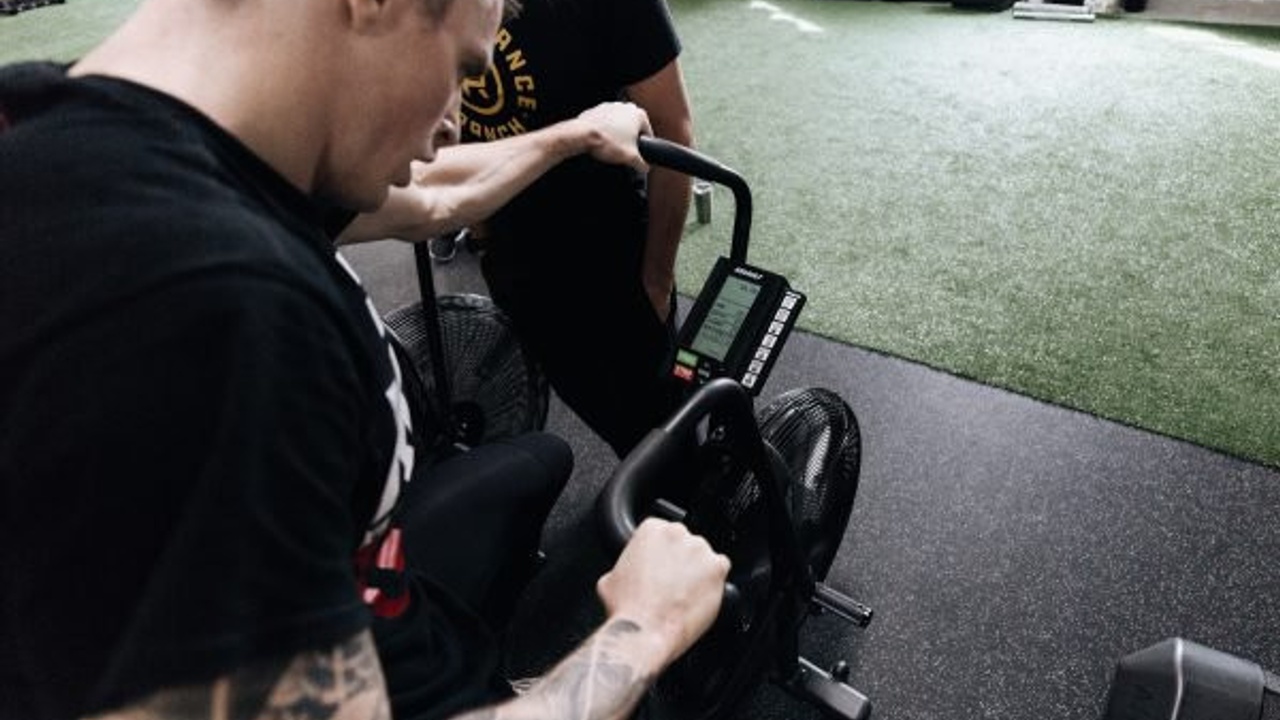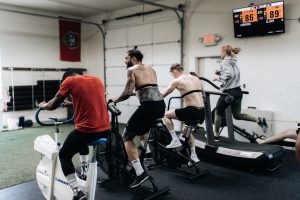
Energy System Development : Concepts and Methods for Conditioning Combat Athletes
By Craig Ansbach
Conditioning is one of the most critical aspects of performance for any combat athlete. An athlete in proper condition can keep a high pace through a full MMA fight, be fresh in the final match of a BJJ tournament, and can be the difference between victory and defeat. While conditioning is a big piece of the performance puzzle, training for it takes many forms. It can be a perplexing topic for coaches and athletes alike and can be misinterpreted or poorly implemented. Proper conditioning improves performance by allowing an athlete to have a sustained output at different intensities during a fight. Unfortunately, conditioning is often done for the sake of making an athlete tired or making them feel like they put in the work. While this method may make someone feel like work is being done, it does not serve the ultimate purpose of conditioning; improve the athlete’s performance.
 Before coaching and working with athletes, I was a combat athlete myself. I have been training and competing in Brazilian Jiu-Jitsu for over 12 years and have tried almost every conditioning method there was to try and get an edge on the competition. I tired many methods in my early days of BJJ that would be laughed at by current S&C standards (training masks, tire flipping, etc.). It was not until several years of trial and error along with my first undergraduate exercise physiology classes that I began to understand that there was more to conditioning than just finding new ways to get tired.
Before coaching and working with athletes, I was a combat athlete myself. I have been training and competing in Brazilian Jiu-Jitsu for over 12 years and have tried almost every conditioning method there was to try and get an edge on the competition. I tired many methods in my early days of BJJ that would be laughed at by current S&C standards (training masks, tire flipping, etc.). It was not until several years of trial and error along with my first undergraduate exercise physiology classes that I began to understand that there was more to conditioning than just finding new ways to get tired.
Our body has multiple systems to provide energy for everything from survival to performing at the highest levels. Depending on the sport, an athlete may have one energy system that is well developed while the others are in poor condition. An athlete that is in good condition should have all their energy systems well developed. It is the job of the coach to have a basic understanding of how the body’s energy systems work and how they relate to performance improvements in the cage or on the mat.
The Science Behind Energy Systems
 ATP (adenosine triphosphate) is the body’s one and only fuel source and is required for every movement we do, no matter how big or small. Our body has several energy systems and each one has its own unique way of providing ATP. Some systems provide ATP almost instantly while others may take more time but can produce more ATP. There are three primary energy systems in the human body as it pertains to athletic performance. Each system provides ATP to the body under certain intensities and durations. It is important to note that all our energy systems are working at once but one system will be dominant while the others “work in the background” depending on the intensity of the activity.
ATP (adenosine triphosphate) is the body’s one and only fuel source and is required for every movement we do, no matter how big or small. Our body has several energy systems and each one has its own unique way of providing ATP. Some systems provide ATP almost instantly while others may take more time but can produce more ATP. There are three primary energy systems in the human body as it pertains to athletic performance. Each system provides ATP to the body under certain intensities and durations. It is important to note that all our energy systems are working at once but one system will be dominant while the others “work in the background” depending on the intensity of the activity.
These 3 Energy Systems:
1. The anaerobic- alactate system is responsible for the high intensity output for a short period of time.
This system can supply energy for about 20 seconds. While this energy system can provide a rapid source of energy almost instantaneously, the down side of it is that is can only last for a very short time and can take a few minutes to replenish. For fighting, this would be any rapid or explosive movement such as a combination of strikes or a double leg takedown.
2. The anaerobic-lactate system works at a moderate to high intensity for the duration of 30 seconds to roughly 2 minutes.
This system can not supply ATP as immediate as our anaerobic-alactate system but is able to supply energy at a moderately high intensity for an extended period of time. For fighters this would be working for a take down against the cage or working to maintain a top position on the ground for an extended period of time.
3. The aerobic system is designed for low intensity and long duration activates.
The aerobic energy system is prominent in activities starting at 2 minutes and lasting for over 90 minutes. Many fighters develop their aerobic base by doing roadwork for a long steady distance. Having a well developed aerobic system helps ensure an athlete can compete for the total duration of their fight in an effective manner.
These three energy systems work hand in hand to successfully provide energy to the body. Each system plays an important role during a fight so all three energy systems should be well developed if an athlete wants to perform at a high level. Now that we have established an understanding of the energy systems at play for performance, we can start looking at how it relates to the specific sport.
Applying the Science to Combat Sports
 Understanding the physiology behind energy system development is important but it’s not effective if the coach can not apply the science to the gym floor and produce results for their athletes. The first step to applying the science is to understand the physical demands our athletes will experience when competing. A standard mma fight for example is three 5 minute rounds. A BJJ black belt competing in a tournament may have to compete in several 10 minute matches. While each style of fighting may have its own unique qualities and demands, most fights require a mix of a high aerobic base with peaks of high intensity and output.
Understanding the physiology behind energy system development is important but it’s not effective if the coach can not apply the science to the gym floor and produce results for their athletes. The first step to applying the science is to understand the physical demands our athletes will experience when competing. A standard mma fight for example is three 5 minute rounds. A BJJ black belt competing in a tournament may have to compete in several 10 minute matches. While each style of fighting may have its own unique qualities and demands, most fights require a mix of a high aerobic base with peaks of high intensity and output.
A second consideration when planning for conditioning training is to look at the intensities our fighters train at. That is because this is where they spend most of their time. In most cases, mma and BJJ athletes training is done in the middle zone. This includes sparring, wrestling, rolling, and bag work. Most of these activities are done at a moderate intensity for a long period of time and as a result, a large potion of an athletes total training time is done in this zone. Because of this, most athletes are very well developed in the moderate intensity activities but often lacking in a well developed high and low intensity energy system output. Being over developed in one energy system can have negative effects on the body and can result in over training. Coaches need to develop communication and relationships not only with our athletes but also with their skill coaches to get a full understanding of what they are going through in camp. That way they can program more efficiently to improve their performance while avoiding fatigue and potential risks for injury.
Once a coach has a clear understanding of what the demands of their athlete’s sports are and the intensity of their skill training, then the methods can be chosen to start improving the athletes conditioning.
Methods for Conditioning Energy Systems
Once the concepts behind energy systems are understood and we know the purpose for why we need conditioning in our program, then we can begin to select the best methods that match our athletes needs. There are many different tools/methods that can be used to achieve the desired outcome when developing each energy system. It doesn’t matter if you are in a facility with all the newest conditioning equipment or in a garage gym with little equipment, as long as you have an understanding of the concepts you should be able to apply them to any equipment you have access to so that it produces the desired conditioning outcome.
Here are just a few methods that we implement at the Performance Ranch that have produced results with our combat athletes.
Anaerobic-Alactate Conditioning:
Equipment Based Sprint Intervals
This is one of the best methods to develop the anaerobic-alactate system because it allows athletes to reach very high intensity levels in a very short amount of time. There are multiple pieces of equipment that will allow athletes to reach these intensity levels including an Airdyne bike, Versaclimbers, curve treadmill and rowers. After picking the equipment, follow these steps:
- Have athletes on equipment perform high intensity sprint (95%-100% max effort)
- Sprint should last 8-12 seconds
- Rest for 1 minute
- Repeat sprint for 8-12 reps
- Maintain consistent number for watts, RPM, or distance in every sprint
Anaerobic-Lactate Conditioning:
VO2 Max Intervals
This method is designed to work athletes at or just above the anaerobic lactate system. The goal for this drill is to have consistent effort (85%-90% max effort) for an extended period of time and repeat for several rounds. Follow these steps and watch the video for the basics of the VO2 Max interval workout:
- Have athlete perform high intensity effort on equipment for 90 seconds-3 minutes
- Rest for 1-2 minutes depending on athletes conditioning level
- Repeat for 3-4 rounds
- Maintain a consistent variable (rpm, distance, watts) for every round
Aerobic Conditioning:
Recovery & Mobility Circuit
On Fridays we have a recovery and mobility program set for our fighters to finish off a hard week of training. By the end of the week most fighters are normally worn out and tired from a hard week of training. This program is designed to not only have our athletes work in the aerobic zone but also improve their mobility.
To design your own circuit, follow these steps:
- Pick 4-6 mobility drills of your choice
- Repeat each drill for 30-45 seconds at low intensity
- Move continuously between drills with little to no rest
- Complete 3-5 rounds
Other Sports
 Sometimes it’s good to just get out of the gym and get out on the field for pick up game of ultimate frisbee or another sport other than fighting. When some of our fighters are in camp they like to break up the monotony of training and do something different. Getting outside of the gym, whether its playing a game of ultimate frisbee or going for a mountain bike ride, are great ways to build off the aerobic base (or high intensity systems depending on how hard you go) without really thinking about training. It is also a great way to build relationships between the athletes and the coaches.
Sometimes it’s good to just get out of the gym and get out on the field for pick up game of ultimate frisbee or another sport other than fighting. When some of our fighters are in camp they like to break up the monotony of training and do something different. Getting outside of the gym, whether its playing a game of ultimate frisbee or going for a mountain bike ride, are great ways to build off the aerobic base (or high intensity systems depending on how hard you go) without really thinking about training. It is also a great way to build relationships between the athletes and the coaches.
Recovery During Conditioning Training
Work+Rest=Success
Almost all athletes have no problem doing the work part of the above equation but often times struggle with the rest portion. Having all the methods for conditioning at your disposal will do little to no good if you do not understand how to manage the recovery in between sets. The recovery portion of the conditioning drills are just as important as the actual output our athletes put out. If too short of a recovery time is given during high intensity day, the athletes performance will suffer and we will lose an opportunity to not only get better but also possibly take way from training sessions done later that day. Time is the standard way to measure rest in between sets (rest 1 minute and then go again). While time is sufficient in many cases, there can be a wide variation in between athlete’s physical ability to recover. To account for these variations amongst individual athletes, there are other methods and tools that can be used to track proper recovery to ensure that the desired output is achieved.
Here are two methods, other than time, used to monitor proper recovery during ESD:
Heart Rate:
 In most cases, heart rate is directly related to intensity. HR will generally increase as intensity increases. Having access to a HR monitor and displaying it on a watch or TV will allow the coach and athlete to track HR through the workout. On a high intensity day, HR typically can reach 90%. If HR hasn’t gone down to roughly 65-70% during the rest, then sufficient recovery hasn’t been reached and more time should be given to reach a lower HR. If using HR as the method of recovery, its important that once the ideal HR zone is reached during rest the athlete is getting back to the exercise and not allowing the HR to get too low.
In most cases, heart rate is directly related to intensity. HR will generally increase as intensity increases. Having access to a HR monitor and displaying it on a watch or TV will allow the coach and athlete to track HR through the workout. On a high intensity day, HR typically can reach 90%. If HR hasn’t gone down to roughly 65-70% during the rest, then sufficient recovery hasn’t been reached and more time should be given to reach a lower HR. If using HR as the method of recovery, its important that once the ideal HR zone is reached during rest the athlete is getting back to the exercise and not allowing the HR to get too low.
If you are using the traditional method of 220-AGE to set a max heart rate be aware that there can be a large variation between individuals when estimating max HR. Many individuals do not fall into this range and can have a higher or lower max HR. The ideal scenario would be to have an established max HR through a testing protocol but if that is not attainable then the 220 method will be acceptable as long as the coach is aware of the possible inaccuracy of this method and has other methods in place like power output.
Power Output (RPM/Watts):
 Most conditioning equipment displays some form of power output. This can be a useful tool to see if our athletes are getting enough recovery between sets. During the early rounds of a high intensity sprint, an athlete may hit 100 RPM on the Airdyne bike. If an athlete rushes to get back to work too soon, the RPM may drop down in the 80’s. This can be a sign that the athlete needs to take a little longer rest so that they can continue to produce a high output.
Most conditioning equipment displays some form of power output. This can be a useful tool to see if our athletes are getting enough recovery between sets. During the early rounds of a high intensity sprint, an athlete may hit 100 RPM on the Airdyne bike. If an athlete rushes to get back to work too soon, the RPM may drop down in the 80’s. This can be a sign that the athlete needs to take a little longer rest so that they can continue to produce a high output.
Final Thoughts on Conditioning for Combat Athletes
In conclusion, there is more to conditioning for combat athletes than just making them tired. Instead, conditioning should be looked at as a way to develop all of our body’s energy systems. We discussed the three major energy systems and their interplay as it relates to performance. The importance of understanding the demands combat athletes must endure during training and competition is also crucial when programing an ESD program. Finally, the methods we choose for energy system development are important but not as critical as our understanding of the underlying concepts of energy systems and how they effect the desired outcome to serve our training.
When programing your next ESD program, keep these points in mind:
- Conditioning is not just a means to make your athletes tired
- Understand the basics of the 3 energy systems and how they relate to performance
- Take the time to understand the physical demands required for your athlete’s competition
- Make sure an athlete’s energy systems are well rounded
- Have some tools or processes to measure recovery during conditioning
 Coach Craig is a strength and conditioning coach at the Performance Ranch in Albuquerque New Mexico. He is a brown belt in Brazilian Jiu-Jitsu and has coached numerous BJJ and mma athletes over the years.
Coach Craig is a strength and conditioning coach at the Performance Ranch in Albuquerque New Mexico. He is a brown belt in Brazilian Jiu-Jitsu and has coached numerous BJJ and mma athletes over the years.
Follow Craig on Social Media:




